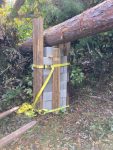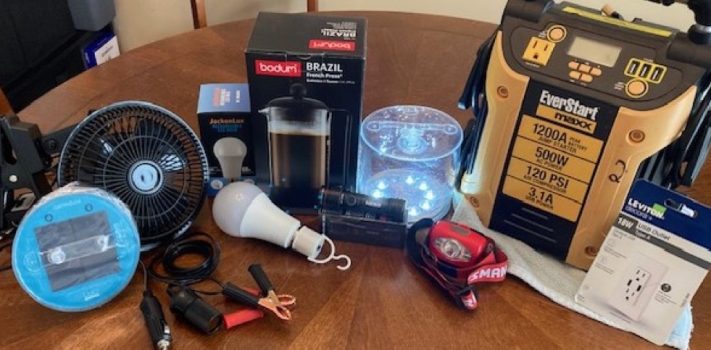(Continued from Part 2.)
 Other than cutting the fallen trees off of our state road to gain access to the greater community, the only additional sawing we did was to clear the brush from our access to the larger hen house. Seeing that a massive white oak was bearing down on the fair-sized pine resting on the chicken run, I used two adjacent stacks of 12-inch block tied together with lumber and ratchet straps to pick up the load until I could remove the tree.
Other than cutting the fallen trees off of our state road to gain access to the greater community, the only additional sawing we did was to clear the brush from our access to the larger hen house. Seeing that a massive white oak was bearing down on the fair-sized pine resting on the chicken run, I used two adjacent stacks of 12-inch block tied together with lumber and ratchet straps to pick up the load until I could remove the tree.
I want to give a huge shoutout and thanks to Thomas Christianson for his January article on giving electric chainsaws an opportunity to prove themselves as I ended up heeding his advice. Shortly after reading that article, I attended a national disaster relief round table and sat in a session hosted by Stihl during which they presented their battery chainsaws and offered us the opportunity to try them. For what they are, meaning battery-powered, I was impressed enough to enquire about availability and pricing once I got home. The saw, speed charger and two of the largest capacity batteries priced out at north of $1,000 and fortunately was not in stock. Sticker shock!
While the dealer was looking up price and availability for me, I saw the 18-inch cordless Echo DCS-5000 56-volt, 5 amp-hour saw hanging on the wall. Since there was no way I could justify the price of the Stihl, I asked the dealer about the Echo for general use and he replied that the previous customers whom he had spoken with after their purchases has been pleased. I bought the Echo kit which included the saw, chain, one battery and the standard charger for $250. When I asked for the price of a second battery, it was $200. So I decided to splurge on a second full battery kit for the additional $50.
The battery chainsaw had more than paid for it itself even before the storm. We used it to work up trees taken down because they posed a fall hazard both here and at my in-law’s home over the Summer. Since the storm I’ve used them for all of our tree cleanup, in some ministry work and found that I give out at the same time as one of the large batteries regardless of cutting full bar width or brush. It was easy enough to change out and recharge the batteries while we were on generator power and for times we were away from home and need to recharge, we used the built-in 500-watt inverters on our older style vehicle jump boxes, (shown in header photo and more on these later).
I purchased an Echo cordless pole saw on the Monday after the storm. It also served well and again, I’m very pleased. When I stopped in at the saw shop, the walls were bare excluding five of the same battery powered chain saw kits I purchased. I noticed that the price had risen to $299 and presume the lack of utility power would hamper most from making the purchase at present. I appreciate that I can recharge off of an inverter, deep cycle battery, and basic 100-watt panel. This along with advice from Mr. Christianson and Stihl’s representatives were among the reasons I chose to add an electric chainsaw to my tool kit.
Here is a tangent on an action taken earlier this year that we and two local friends are in agreement over. Between us we had close to two dozen hazard trees which were overhanging homes and buildings professionally removed. This was an aggravating process in that I had to contact six different tree removal companies over three years to find someone who would offer a competitive price and most importantly actually show up to do the job. At home, a pair of 30-inch diameter sweet gums that overhung the building I use to store the tools and supplies for my business were removed. I lacked the skill and tools to do this job and knew it. With their tendency to become hollow with time, there was no doubt one or both of those trees would have eventually fallen and caused substantial damage.
So, the money spent hiring a professional to protect my property was worth every penny. Not having to worry about those tree hazards while the wind gusted and nearby trees toppled was as wise as any other physical good I used post-storm. The two friends referenced also hired the same company I used and volunteered post storm that they too could imagine how much damage their homes would have sustained had they not pro-actively arranged removal of the threatening trees. I implore you to take such hazards into consideration as you implement your risk and security plans.
Our water needs were easily handled using the generator and the on-demand water heater allowed us to take daily hot showers as well as wash pots and pans. We used disposable plates and utensils as much as possible so dishes were minimal. My plan for laundering had the event lasted longer was to run the washing machine off of the gas generator using an extension cord while the water needs were carried by the natural gas unit. Fortunately, we did not reach that point.
We had plans to travel with friends over the weekend Hurricane Helene arrived. Since the area we were to visit has few dining options, each family was taking portions of several potluck meals. Our contribution was to be chili and a broccoli, chicken, and rice casserole. Along with the random leftovers already in our refrigerator these meals saw us through the first week for lunch and supper. For breakfast we ate grits, oatmeal, or made egg scrambles. The sourdough starter was due to be fed on day five so my wife turned the discard into three loaves of bread and two pans of cinnamon rolls. We were in need of a pick-me-up and fresh sourdough cinnamon rolls did the trick. We baked the bread in a propane Camp Chef oven that was purchased for demonstrating sourdough bread making on the homesteader’s show circuit. The only other “cooking” I can remember was making two rounds of coffee each morning. We have a pair of stove top percolators but decided to try using a French press I had stored back after I watched the family on YouTube’s Simple Living Alaska use theirs. It made excellent coffee and was easy to clean.
Did you know that your garden harvests don’t care that your power is off and the roads are full of trees? We worked up the last market basket of sweet onions mid-week. That is why our list of power consumption has the food processor on it. It was also necessary to pick and freeze bell peppers and tie up chilis to dry between our other tasks. Putting the onions into the freezer taught me something. We purchase pre-made pizza crusts and keep several packs in a small chest freezer located in my work shed. I tried spreading out the bags of onions and although I ran the gas generator twice a day to keep the freezer at temperature, the onions were very slow freezing solid. I realized on day three after processing them that the pizza crusts were acting as insulators and trapping the “cold” beneath them. Once I rearranged the freezer the onions froze quickly but the shop overall and freezer in particular still smell strongly of onion.
I have two additional observations on cooking or heating water from interacting with our family and neighbors. Gas grills are extremely inefficient for heating pots. Not being able to lower the lid allows the wind to displace much of the thermal energy. This can matter significantly when a propane grill is all that you have to cook with in an emergency and you either don’t have spare tanks or there is nowhere to get refills. I encountered several cases where others were wastefully burning up their fuel or realizing the predicament they were in, showed worry.
I am a proponent of inexpensive propane stoves. Agri Supply Co. sells a line of 1, 2, and 3 burner tabletop units at a very reasonable price if you are interested. You will need to purchase a regulator and hose assembly to complete the unit, but they are simple and reliable. All of our pressure and water bath canning is done on these units. The butane catering style stoves are also a valuable resource. These small units are safe for indoor cooking and the fuel canisters resemble spray paint cans. A fuel can is rated for two hours on full temperature and the canisters can be purchased in twelve packs for $35 locally.
(To be concluded tomorrow, in Part 4.)










